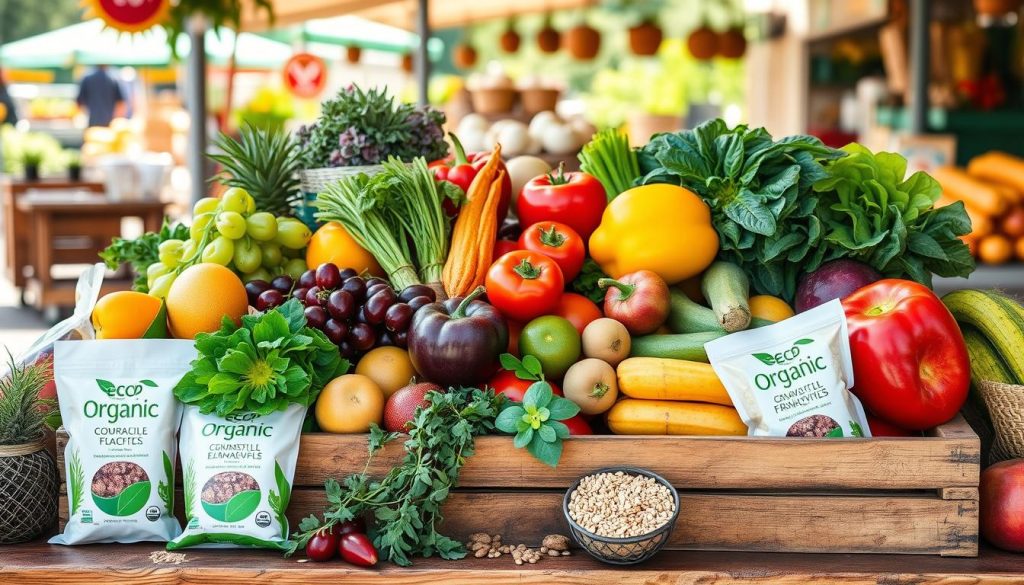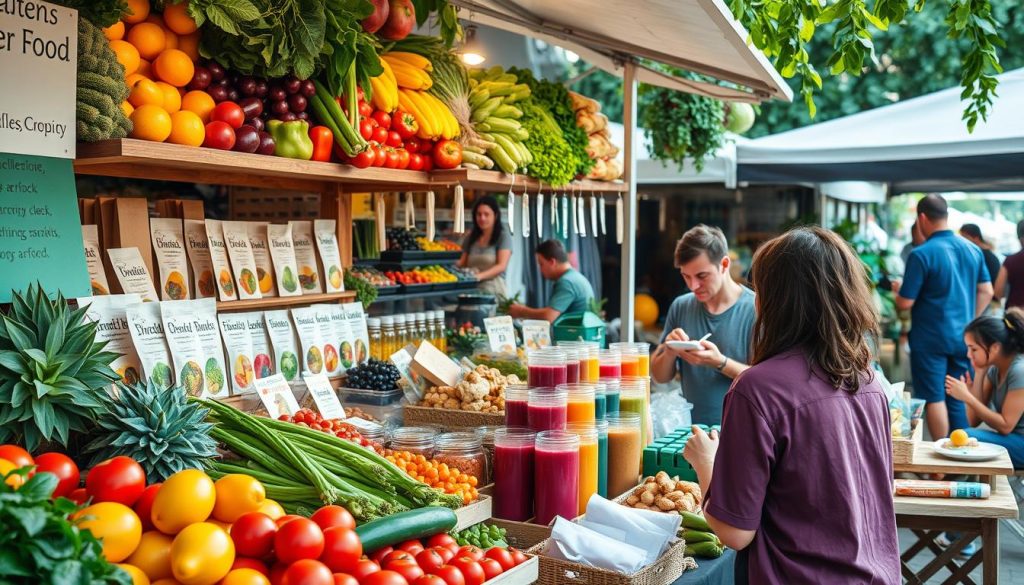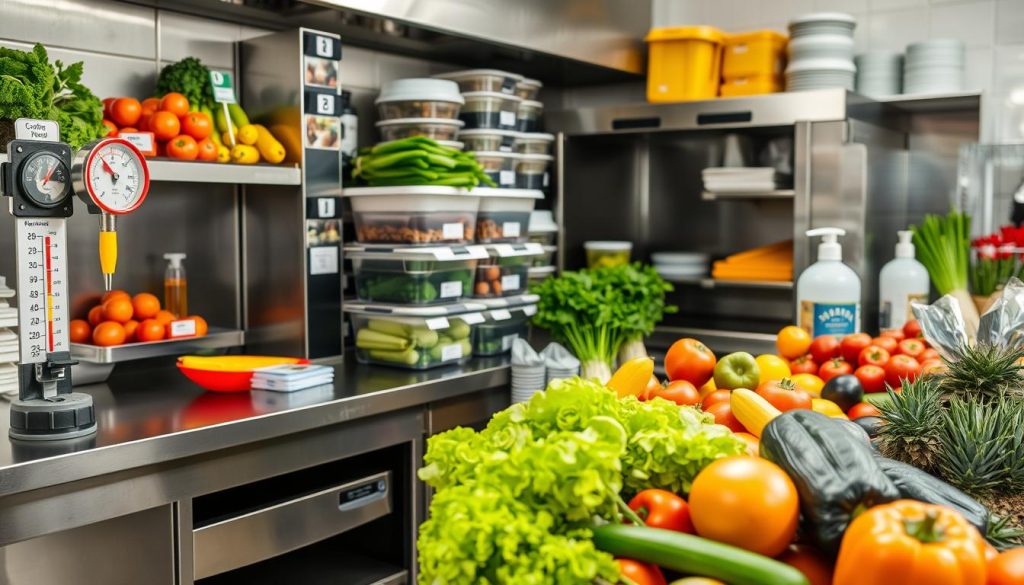The UK market is changing, and people want healthier food options more than ever. This creates great chances for newbies to start a business in fresh, healthy food. If you’re starting out, you can match your interests with a growing market of health-aware consumers. This guide will help you lay a strong base for your business. It will also show you what this guide covers, helping new entrepreneurs feel sure about starting a healthy food business.
Understanding the Healthy Food Market

The healthy food market has changed a lot as more people focus on their health. Now, there’s a big increase in demand for organic, plant-based, and functional foods. This shows how UK consumers’ tastes are changing.
Key factors shaping the healthy food market include:
- Increased awareness of nutritional values and their impact on overall wellbeing.
- Growing popularity of dietary restrictions such as veganism and gluten-free diets.
- The influence of the wellness movement on daily food choices.
Reports from the industry show that people now prefer foods with wholesome ingredients. Younger people especially like brands that are open about what they use and how they make their products. This change gives businesses a chance to meet these new needs.
Understanding the healthy food market helps entrepreneurs make better choices. It helps them make sure their products match what today’s shoppers want and need.
Identifying Your Niche in Healthy Food

Finding a special spot in the healthy food market is key for new business owners. It helps them know exactly where their products will connect best with people. This focus can make customers more loyal and engaged.
There are many areas within the healthy food industry. Each one meets different tastes and dietary needs. Here are some examples:
- Meal prep services for those with little time.
- Food products for specific diets like gluten-free, vegan, or keto.
- Health foods for kids, making eating fun and healthy.
- Senior-friendly foods that are easy to eat and nutritious.
Successful brands show how powerful focusing on a niche can be. For example, organic baby food or fitness snacks target specific groups. They fill a market need and build a strong bond with their audience. By looking at these successes, new businesses can get ideas for their own paths.
Healthy Food Business Ideas for Beginners

Starting a healthy food venture is exciting for those keen to explore new business ideas. These ideas meet the growing demand for health-conscious choices. Entrepreneurs can tap into trends that favour wellness.
Exploring Various Concepts
There are many options in the healthy food sector for beginners. Here are some fresh ideas to start your business:
- Smoothie bars with fresh, organic ingredients.
- Meal delivery services with nutritious, balanced meals.
- Organic food trucks for healthy meals on the move.
- Plant-based cafes with a vegan menu.
- Subscription boxes for healthy snacks at home.
Targeting Specific Demographics
Knowing who you want to sell to is key to a successful business plan. By focusing on certain groups, you can meet their specific needs:
- Fitness lovers needing protein-rich meals or pre-workout snacks.
- Parents wanting healthy snacks for their kids.
- Seniors looking for easy meal options that are balanced.
Using data on consumer behaviour can give you insights into these groups. This ensures your healthy food ideas hit the mark with your target audience.
Benefits of Starting a Healthy Food Business

More people want to live healthier, which is great news for those thinking of starting a healthy food business. This market is changing fast because people know more about nutrition and wellness. Starting a business in healthy food can make you and your customers healthier. It also means you could make a good profit.
Health Conscious Consumers
Now, people are choosing their food with health in mind. This change is good for healthy food businesses. It means:
- More people looking for healthy food choices.
- Chances to teach customers about the health perks of certain foods.
- The chance to build strong customer relationships by being open and quality-focused.
Talking to health-aware customers can make your brand stronger and get them to buy from you again. This helps your business grow over time.
Profitability and Market Trends
Healthy food businesses can make good money by being smart about what’s popular now. People want more organic, plant-based, and foods with less processing. The reasons for this include:
- More money being spent on health and wellness products.
- More people knowing about health issues linked to food.
- More interest in eating ethically and sustainably.
Some businesses are doing well by offering what people want. Health-focused restaurants, meal prep services, and health food stores are doing great. By offering products that match these trends, businesses can make more money.
Researching Your Competition

In the healthy food market, knowing your competitors is key to success. A deep dive into their strengths and weaknesses can reveal a lot. It shapes your marketing and shows where you can stand out.
Starting with market research is vital. Tools like SWOT analysis help by looking at strengths, weaknesses, opportunities, and threats. This helps you see where you and your rivals stand.
Listening to what customers say adds more insight. Reading reviews and testimonials shows what people like and dislike. This helps you make products that meet their needs.
Using online tools and keeping an eye on social media and industry news is also helpful. It keeps you informed about what your competitors are doing. These steps build a strong base for your healthy food business.
Creating a Business Plan for Your Healthy Food Venture

Creating a strong business plan is key for a healthy food business. It acts as a guide, showing your goals and how to reach them. It helps you stand out in a crowded market.
Good planning sets the direction for your business. It makes sure you meet customer needs and follow industry trends.
Essential Components to Include
A good business plan should have these parts:
- Market Analysis: Know who your customers are and what they like. Keep up with healthy food trends.
- Marketing Strategies: Explain how you’ll promote your food, both online and offline.
- Funding Sources: Look into different funding options like loans, investors, or grants.
- Financial Projections: Show your expected earnings, profits, and costs for the first few years.
- Operational Plan: Describe how your business will run, including how you’ll get supplies and who you’ll need to hire.
Setting Realistic Goals
It’s important to set achievable and measurable goals. Make sure they’re based on solid market research. This way, you can adjust your plans as needed.
Having both short-term and long-term goals is key. It helps you stay flexible and ready for changes in the health food market. Aim high but be realistic to make the best strategies as you learn more.
Legal Considerations for Healthy Food Businesses

Starting a healthy food business in the UK means dealing with many legal rules. It’s key to know the laws set by bodies like the Food Standards Agency. These laws make sure food is safe for everyone.
First, entrepreneurs must register their business with local authorities. This step is crucial to follow the law and be seen as a real business. Getting the right permits is also important, especially if you sell food directly to people.
Food safety is a big part of the law. Businesses must keep very clean to keep customers safe. Rules about food labels give people the info they need to choose what to buy.
Following these laws keeps people healthy and protects business owners from legal trouble. It’s important for staff to know about food safety. Being up to date with food business laws is key to doing well in the healthy food market.
Choosing a Location for Your Healthy Food Business

Finding the right spot for a healthy food business is key to doing well. You must decide if you want a physical store or to sell online. Each choice has its own benefits that affect how many customers you reach and how much you sell.
Physical versus Online Presence
Choosing between a shop and an online store is a big decision for many entrepreneurs. A shop lets you meet customers face-to-face and create a lively spot that shows off your brand. Selling online, however, means you can reach more people across the country, fitting with today’s love for ease and home delivery.
Factors Influencing Location Choice
Think about these things when picking the best spot for your business:
- Target Audience: Know where your perfect customers live and what they like to buy.
- Foot Traffic: A busy area means more people see your shop and might stop by on a whim.
- Local Competition: Looking at what others offer helps you spot chances to stand out.
- Accessibility: Make sure your spot is easy for customers to get to, with good transport or parking.
These factors are crucial for your healthy food business. They help you draw in new customers and keep the ones you have.
Developing a Unique Selling Proposition (USP)

Creating a unique selling proposition (USP) is key to standing out in a busy market. A strong USP boosts your brand and gives you an edge over competitors. It’s about showing what makes your products special and attractive to your customers.
- Sustainability: Showing you care for the planet can draw in eco-aware shoppers. Using local farms and eco-friendly packaging speaks volumes to health-minded buyers.
- Local Sourcing: Focusing on ingredients from your community builds a bond with customers. It makes your products more appealing.
- Innovative Flavours: Unique and creative tastes can make your brand stand out. They attract those who love to try new things and food lovers.
Looking at successful brands can help spark your own USP ideas. Brands that focus on organic or cater to special diets, like gluten-free or vegan, gain loyal customers. A clear, strong USP boosts your branding and sets your business up for success.
Marketing Strategies for Healthy Food Businesses

Innovative marketing strategies are key to healthy food businesses’ success. They help increase brand visibility and build community ties. Social media is a top platform for reaching out to customers directly.
Social Media Engagement
Using social media wisely can greatly expand a healthy food brand’s reach. Sites like Instagram, Facebook, and Twitter let businesses share eye-catching content. This builds a strong bond with people who care about health.
Posting recipes, nutritional advice, and interesting images regularly can draw in a loyal crowd.
- Post user-generated content to build trust and authenticity.
- Engage with followers through polls, questions, and live Q&A sessions.
- Utilise targeted ads to reach specific demographics interested in health and wellness.
Collaborations and Partnerships
Strategic partnerships can boost visibility for healthy food businesses. Working with local gyms, wellness centres, or health bloggers can make a big difference. These partnerships often help both sides, leading to more promotion and reaching new people.
- Form alliances with fitness influencers for authentic endorsements.
- Organise events or workshops in partnership with local health organisations.
- Offer exclusive discounts to members of local gyms or fitness centres.
Sourcing Quality Ingredients for Your Offerings

Starting a healthy food business means finding top-notch ingredients. Working with local suppliers helps make your products stand out. We’ll look at why partnering with local farmers and suppliers is good. We’ll also compare organic and conventional ingredients.
Local Farmers and Suppliers
Working with local farmers has many perks. It cuts down on transport costs and helps the environment. You get fresher ingredients, which makes your products better. Plus, it helps build strong community ties, which can make your brand more trusted.
- Access to fresh, seasonal produce
- Improved quality and taste of ingredients
- Strengthening community ties
- Potential for unique offerings based on regional specialties
Organic versus Conventional Ingredients
There’s a big debate over organic vs conventional ingredients. Organic options appeal to those who care about the planet and health. They might cost more but are seen as better for the environment. On the other hand, conventional ingredients are cheaper but might have additives some people don’t like. Knowing this can help you make better choices.
- Organic ingredients support sustainable agriculture
- Conventional ingredients may be more cost-effective
- Consumer trends indicate a growing preference for organic options
- Transparency in sourcing builds trust with your customers
Building a Strong Brand Identity

Creating a strong brand identity is key for a healthy food business. It’s the base for brand growth and is vital for marketing. A strong brand identity shares what the business stands for and connects with its customers.
When building a brand identity, consider these key elements:
- Logo Design: A memorable logo is crucial for being recognised. It should reflect the brand’s values and mission.
- Colour Schemes: The colours chosen can stir emotions and shape how people see the brand. For example, greens often mean freshness and health.
- Messaging: A clear, consistent message strengthens the brand identity. It should match the brand’s values and speak to the target audience.
Looking at successful healthy food brands can show us how to brand well. Brands like Innocent and Green & Black’s show how a strong brand identity builds loyalty and broadens the market. A real brand story and consistent elements boost brand recall and customer interaction.
Setting Up Your Online Presence

Having a strong online presence is key for any healthy food business today. A good website shows off your products and helps engage with customers. The right website can really boost your e-commerce success.
Website Essentials for a Healthy Food Business
Here are the must-haves for a great online presence:
- User-Friendly Design: A simple layout makes it easy for visitors to find what they need, making them more likely to look around.
- Mobile Optimization: With more people shopping on phones, having a site that works well on mobile is a must for a good experience.
- Compelling Content: Great photos and detailed descriptions of your healthy food can really grab potential customers’ attention.
- E-commerce Functionality: Adding shopping carts and secure payment options makes buying from you easy and safe.
- Search Engine Optimisation (SEO): Good SEO practices can make your site more visible online, bringing in more visitors.
By focusing on these areas, you can build a strong online presence. This sets the stage for your healthy food business to grow.
Pricing Strategies for Healthy Food Products

Setting the right prices is key for healthy food products to stand out in a crowded market. Business owners need to pick the right pricing models. This ensures their products draw in customers and stay profitable.
Competitive pricing is a common method. Companies look at what others charge to set their prices. Alpro uses this approach well. They match their prices with similar products to attract customers without losing quality.
Value-based pricing puts a price on the health benefits of products. Innocent Smoothies, for example, focuses on the health perks and quality of their ingredients. This strategy can help charge more, appealing to those who value health.
Psychological pricing plays a role too. It means setting prices just below a round number, like £9.99 instead of £10. This makes products seem like a good deal. A premium granola brand might be priced at £4.99, making it seem more affordable.
When setting prices, think about production costs, who you’re selling to, and what customers are willing to pay. Knowing these things helps businesses create prices that fit their brand and meet customer needs.
Ensuring Compliance with Health Regulations

In the healthy food business, following health regulations is key. It keeps customers trusting you and makes sure your products are safe. Knowing the UK’s food safety laws is a must for staying compliant. These laws set the health standards that food businesses must follow. This includes keeping food safe and clean.
Understanding Food Safety Standards
Food safety standards cover many practices to keep people healthy. Businesses must follow strict cleanliness rules and train their staff well. Staying in line with these rules protects customers and boosts the business’s image.
- Implementing effective food handling procedures.
- Conducting regular hygiene training for employees.
- Maintaining a clean and safe food preparation area.
Using checklists can help make sure you’re meeting all food safety rules. It’s also important to keep up with new laws. By focusing on these areas, businesses can meet health standards and create a safer food space.
Scaling Your Healthy Food Business

Once your healthy food business is strong, it’s time to think about growing. Using smart strategies can help you expand and reach more customers. These methods can boost your business’s growth.
Strategies for Growth
Here are some ways to grow your business:
- Expanding Product Lines: Add new items that fit your brand. For example, offering gluten-free or vegan options can draw in more customers.
- Opening Additional Locations: Look for places where people want healthy food. Study what customers like and pick spots that fit well with your current places.
- Franchising Opportunities: Think about franchising for quick growth. Create a successful business model to draw in franchisees who can share your brand well.
- Increasing Online Reach: Use digital marketing to grow your online presence. Run social media campaigns, work with influencers, and use targeted ads to get more customers.
- Collaborating with Other Brands: Work with brands that match yours for co-branded products or events. This can help you reach new customers and benefit both brands.
Healthy food brands like Green Kitchen and Whole Foods Market show how these strategies work well. They planned and executed their growth carefully. Having a clear vision and being adaptable is key for growing a business sustainably.
Networking and Support for New Entrepreneurs
Starting a business in the healthy food industry means you need to network a lot. Making friends with people who think like you can give you great advice and help you work together. Sharing stories and learning from each other helps you find new ways to solve problems. This is why support for entrepreneurs is so important, as a strong network can lead to lasting work relationships that help your business grow.
Being part of industry groups is a great way to network and find important business tools. These groups often host events like seminars, workshops, and conferences where you can meet leaders and other entrepreneurs. These events help you learn about market trends and can lead to mentorship chances. Working with experts in the healthy food industry can guide you through the tough parts of starting a business.
It’s also key to look for resources that help you grow professionally in the healthy food field. Many groups offer training on important topics like marketing, being eco-friendly, and following food laws. Keeping up with new skills keeps you ahead in a fast-changing industry. Using networking and support can turn obstacles into chances for success in your healthy food business.
















